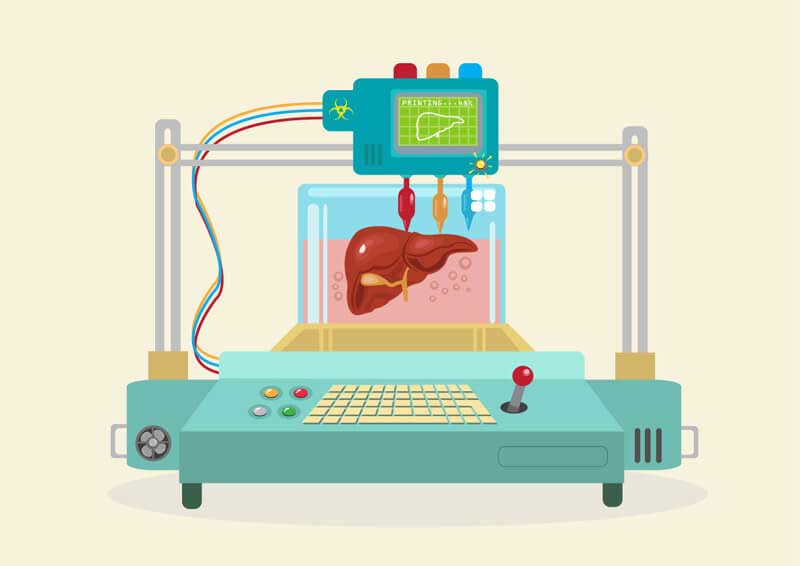- 3D printing is becoming a lot cheaper
- Manufacturing is going to change completely
- We’re already able to print food
- What are the potential benefits for the healthcare sector?
- 3D printing in construction
- What if this technology falls into the wrong hands?
3D printing is set to be a major disruptive force for almost all industries. We can print small parts for manufacturing industries, construction material for building houses and we are even able to print organic tissue. Printers have always been intriguing pieces of technology. You create something on the screen of your PC and all of a sudden a sheet of paper with your design comes out of a machine. Then came ideas of printing parts and voilà, the 3D printers started the revolution. They are still pretty slow and require a lot of work and different materials to actually produce meaningful stuff, so we are still far away from having a magic machine spitting out anything we can think of. However, this technology is moving forward rapidly and we even heard some of the notable futurists speak about what if 3D printing was a lot faster, like 100 or 1000 times faster? Would it change the way we work or live?
Free trendservice
3D printing is becoming a lot cheaper
You can buy a basic 3D desktop printer for around 700 euro or so, which is obviously limited in terms of the size of the objects you can print and the materials you can use. More sophisticated 3D printers are available for a few thousand euro. The printing capabilities of these machines are obviously a lot more varied and although the prices are still relatively high, they are expected to drop significantly once they become more widely used and produced.
Manufacturing is going to change completely
If you’re using the budget printers we just mentioned then you’re limited to smaller items and one or two materials, but in the long term these devices will become more and more capable: goods and parts won’t need to be shipped from one end of the country to another, because they can be printed on-site, with designs sent across the world in seconds.
We’re already able to print food
Most 3D printers use some type of plastic to bring designs to life, but many other materials can be printed: including food. The Foodini from Natural Machines in Barcelona is one of those devices capable of producing everything from pizzas to cookies, all using fresh ingredients prepared before printing. In the not-too-distant future you could be getting both your meals and your cutlery from a 3D printer. Your 3D printer will become your chef, and recipes will be downloadable from the internet!
What are the benefits for the healthcare sector?
Healthcare is one of the areas where 3D printing is really taking off – it enables doctors and surgeons to create custom splints and body part replacements that are individually tailored to each patient rather than produced en masse. It can also help surgeons to plan operations in advance in ways that wouldn’t otherwise be possible. Being able to print all the organs you need for the operation will definitely change the way surgeons carry out surgical procedures, minimising possible errors.
3D printing in construction
There have been a number of 3D printed construction projects, for instance in the Netherlands and China. Although the architectural design of these structures is basic and the materials used are limited, the 3D printing technology could make a tremendous difference when used in areas where natural disasters have occurred or in areas where there’s a large displacement of people who need shelter, such as war torn areas. As is the case with all other elements of 3D printing, its technology is rapidly progressing and will continue to do so in years to come.
3D printing in space?
We’ve mentioned how 3D printing can change manufacturing thanks to the way designs can be transmitted to anywhere in the world. The same applies to space travel. Imagine a colony on Mars where living pods can be 3D printed, or a spaceship that’s able to 3D print its own replacement parts with designs sent from ground control? The story of Apollo 13 would’ve played out very differently with a 3D printer on board.
What if this technology falls into the wrong hands?
Like with any technology, 3D printing could be used for sinister purposes as well. Imagine being able to print real working weapons and bombs? American student Cody Wilson has already successfully made a completely functional .380 calibre handgun just using a 3D printer.
Conclusion
3D printing is clearly a technology wave of the future. Once science fiction, it is now very much reality and it is shaking up our lives and industries across the globe. The possibilities for 3D printing applications are limitless, yet the development of the technology is highly dependent on the printing speed of these machines. In the years to come, we will all have such a magical machine enabling us to print everything we could ever want with templates and instructions. All we’ll need to do is order the materials.
Share via:




